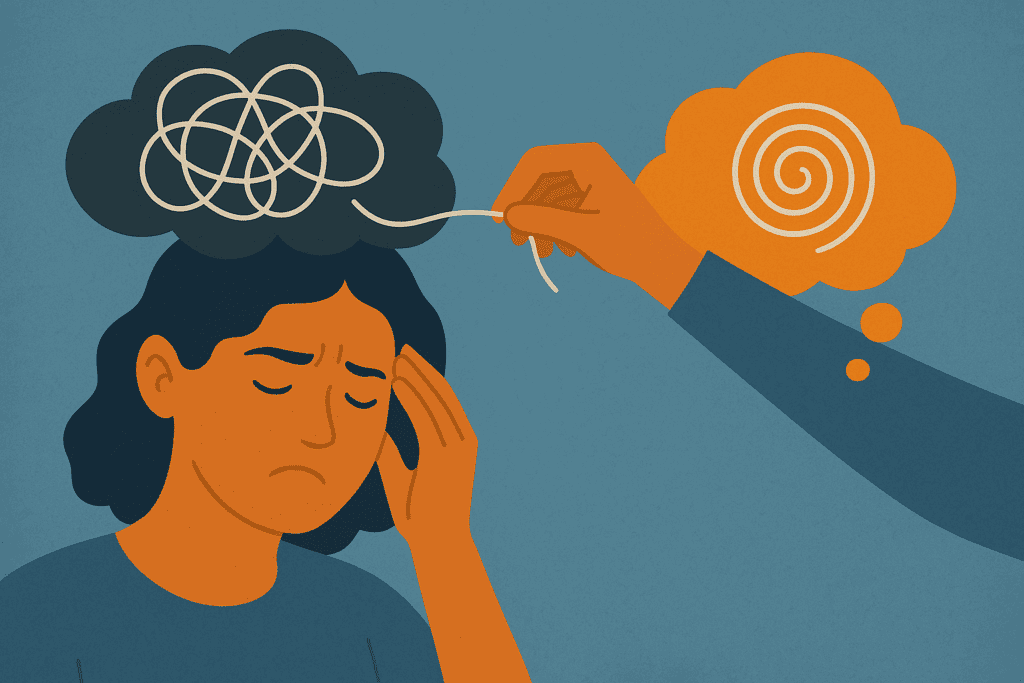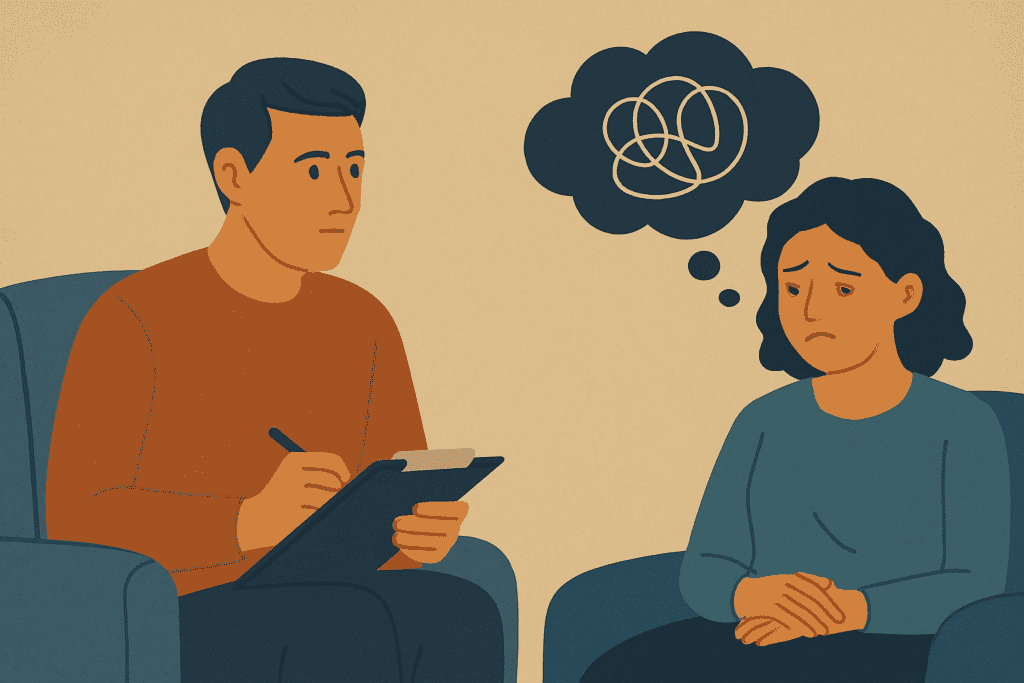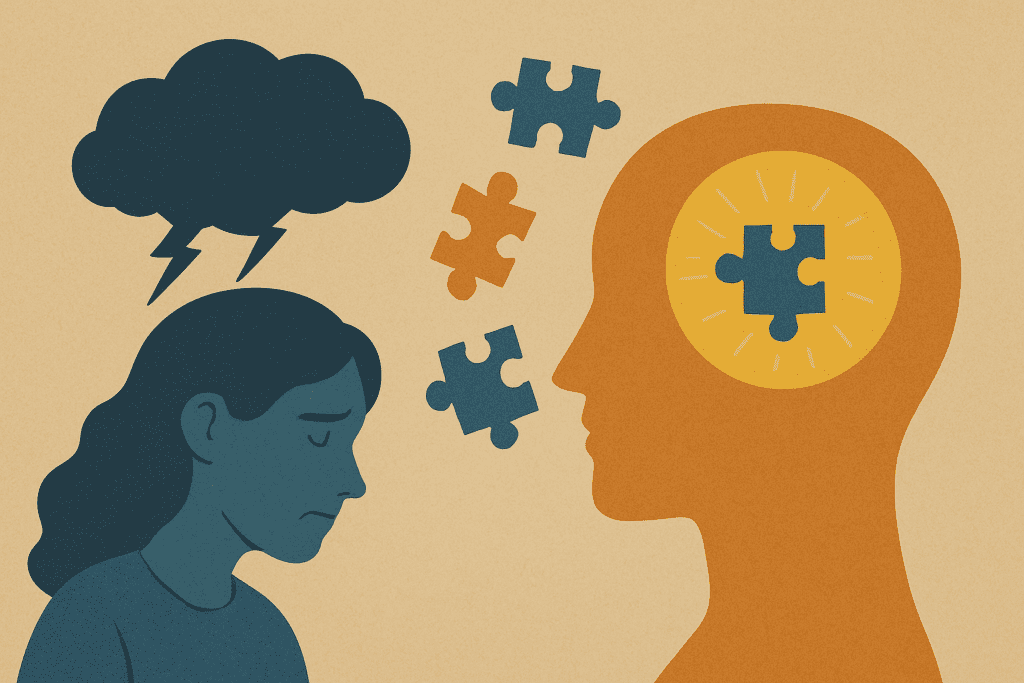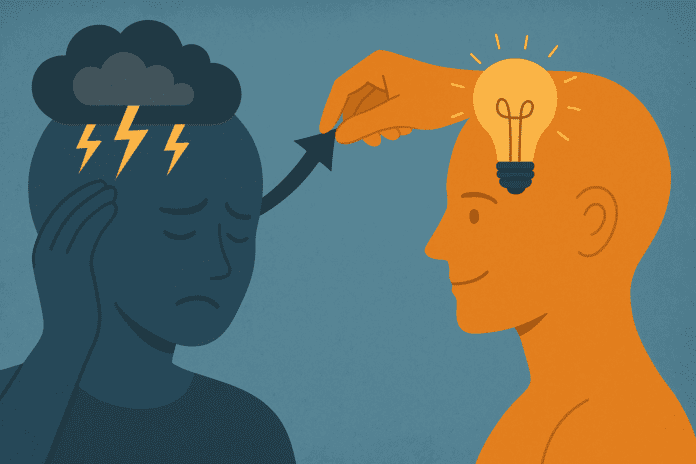In the intricate realm of trauma recovery, few therapeutic approaches have garnered as much scientific support as cognitive behavioral therapy. Commonly referred to as CBT, this structured, evidence-based treatment has been a cornerstone in the management of post-traumatic stress disorder (PTSD). Through a combination of cognitive restructuring, behavioral strategies, and neurological recalibration, cognitive behavioral therapy for PTSD offers more than symptom relief; it provides a pathway to profound transformation. As research continues to advance, mental health professionals are increasingly emphasizing how CBT can rewire the brain and alleviate the persistent psychological and physiological burdens associated with trauma. This article dives deep into the mechanisms, efficacy, and lived experience of using CBT for post-traumatic stress disorder, drawing on both cutting-edge neuroscience and expert clinical insight.
You may also like: How Does CBT Work to Improve Relationships and Communication? Science-Backed Techniques for Getting Along with Others
Understanding PTSD: A Neurological and Psychological Landscape
Post-traumatic stress disorder is far more than a lingering memory or emotional disturbance. It represents a complex interplay between psychological perception, emotional regulation, and physiological response. At its core, PTSD is the result of a brain that has been overwhelmed by stress, resulting in hypervigilance, intrusive thoughts, dissociation, and emotional dysregulation. The amygdala, hippocampus, and prefrontal cortex—three key regions of the brain—become dysregulated after trauma. The amygdala, the brain’s fear center, becomes hyperactive; the hippocampus, which processes context and memory, often shrinks in volume; and the prefrontal cortex, responsible for rational thinking and emotional regulation, becomes underactive.
This neurological shift is not just theoretical. Neuroimaging studies have repeatedly shown that individuals with PTSD exhibit altered brain function, particularly in these regions. The chronic activation of the sympathetic nervous system—the body’s stress response—leads to elevated cortisol levels and ongoing physiological tension. In other words, the body remains in a state of fight-or-flight long after the threat has passed. It is within this biologically altered landscape that cognitive therapy for PTSD finds its most significant value. By targeting thought patterns and behaviors that maintain the trauma response, CBT helps recalibrate not only the mind but also the brain’s neurocircuitry.
How CBT Works: A Brain-Based Intervention for Trauma Recovery
Cognitive behavioral therapy is more than a surface-level intervention. It operates at the intersection of cognition, emotion, and neurobiology. The foundational principle of CBT is that our thoughts, feelings, and behaviors are interconnected—and that by changing maladaptive thoughts, we can influence emotional and behavioral outcomes. For someone with PTSD, these maladaptive thoughts often revolve around guilt, shame, mistrust, or fear of recurrence. CBT for PTSD helps patients identify and challenge these cognitive distortions through structured techniques such as cognitive restructuring, exposure therapy, and behavioral experiments.
Cognitive restructuring involves helping individuals recognize irrational or distorted beliefs and replace them with more balanced, evidence-based thoughts. For example, a trauma survivor may believe, “The world is completely dangerous,” or “I should have prevented what happened.” These beliefs, while understandable, often exacerbate PTSD symptoms. Through guided questioning, Socratic dialogue, and homework assignments, patients learn to evaluate the validity of their beliefs and generate healthier alternatives. Over time, this cognitive shift not only reduces distress but also begins to rewire the brain’s threat appraisal system.
The use of exposure therapy within the CBT framework is particularly powerful. Rather than avoiding trauma-related cues—which can reinforce fear—patients are guided to gradually confront these triggers in a controlled, safe environment. This process desensitizes the brain’s fear circuits and reestablishes a sense of control. Experts note that repeated, intentional exposure leads to measurable changes in amygdala activity, reducing hyperarousal and reactivity over time. The process is not easy, but it is transformative. As CBT therapy and PTSD research evolve together, the results consistently demonstrate long-term improvement in both emotional well-being and brain function.
The Neuroplastic Benefits of CBT for PTSD
One of the most compelling reasons CBT is so effective in treating PTSD lies in the concept of neuroplasticity. Neuroplasticity refers to the brain’s ability to reorganize itself by forming new neural connections. When individuals engage in CBT for post-traumatic stress disorder, they are actively participating in this process. Each time a maladaptive thought is challenged and replaced with a healthier alternative, the brain begins to carve out new pathways. Over time, these new connections become stronger, while the old, trauma-driven patterns weaken.
Clinical studies using fMRI and PET scans have revealed significant changes in brain activity following successful CBT. Reductions in amygdala hyperactivity, normalization of hippocampal function, and increased activation in the prefrontal cortex are among the most documented findings. These changes mirror the improvement patients experience in their daily lives—less reactivity, improved emotional regulation, and a greater sense of safety in the world. In this way, post-traumatic stress disorder cognitive behavioral therapy acts as a neurological reset, helping the brain heal from the inside out.
Importantly, these benefits are not confined to the laboratory. Patients frequently report that after undergoing cognitive therapy for PTSD, they feel more grounded, more in control of their emotions, and less defined by their trauma. These subjective experiences reflect the underlying brain changes and highlight the synergy between cognitive and physiological healing. The brain, once hijacked by trauma, can be gently guided back to balance through intentional, repeated mental training.
Building Emotional Resilience Through CBT
Beyond its neurological effects, CBT for PTSD also helps individuals develop emotional resilience—the ability to adapt to stress and bounce back from adversity. Emotional resilience is not a fixed trait; it can be cultivated through deliberate practice and psychological insight. CBT provides a framework for doing just that. By teaching individuals how to identify and manage negative emotions, challenge cognitive distortions, and implement coping strategies, CBT equips patients with tools that extend far beyond the therapy room.
In trauma recovery, resilience is not about ignoring pain but learning how to face it with courage and clarity. Through CBT, individuals come to understand that their emotional reactions, while intense, are not inherently dangerous. They learn to tolerate distress without being overwhelmed by it. This shift in perspective is powerful. It transforms the narrative from one of helplessness to one of empowerment. Experts in trauma psychology often emphasize that fostering resilience is a critical part of sustainable healing, and cognitive behavioral therapy offers one of the most effective pathways to achieving it.
Additionally, the therapeutic alliance between clinician and patient plays a crucial role in building resilience. In a safe, structured environment, patients can explore painful memories and emotions without fear of judgment. This relational safety, combined with CBT’s structured methodology, creates an ideal context for growth. When patients feel supported and guided, they are more likely to engage fully in the therapeutic process and internalize its lessons. Thus, CBT therapy and PTSD recovery are deeply intertwined in both psychological and relational dimensions.

Real-World Applications and Long-Term Outcomes
CBT for PTSD is not limited to theory or clinical trials—it is being used successfully in diverse settings across the globe. From veterans returning from combat to survivors of domestic violence, sexual assault, and natural disasters, individuals from all walks of life have benefited from this approach. Cognitive behavioral therapy for PTSD has been endorsed by organizations such as the American Psychological Association and the Department of Veterans Affairs as a first-line treatment. Its adaptability and empirical support make it one of the most trusted methods in trauma-focused care.
Long-term studies have shown that the benefits of CBT often persist for years after treatment has ended. This durability is due in part to the skills patients acquire during therapy. Unlike some treatments that offer temporary relief, CBT teaches individuals how to manage their thoughts, regulate their emotions, and respond effectively to triggers. These are lifelong skills that continue to yield dividends long after the final therapy session. Many patients report that even years after completing therapy, they still use the techniques they learned to navigate stress and maintain emotional equilibrium.
Moreover, the effectiveness of CBT therapy and PTSD outcomes improves when the treatment is tailored to the individual. Clinicians may integrate elements of mindfulness, narrative therapy, or acceptance and commitment therapy (ACT) depending on the patient’s needs. This flexibility allows CBT to evolve while maintaining its core principles. As a result, more people can access trauma-informed care that is both evidence-based and personally relevant.
Challenges and Considerations in CBT Treatment for PTSD
Despite its many strengths, CBT is not a one-size-fits-all solution. Some individuals may find the exposure elements of treatment too distressing at first, while others may struggle with the structured nature of the approach. For those with complex trauma or comorbid conditions such as substance use disorders or dissociative symptoms, a modified or phased approach to treatment may be necessary. Clinicians must exercise clinical judgment and cultural sensitivity when designing treatment plans.
Additionally, access to high-quality CBT for post-traumatic stress disorder remains a challenge in some communities. Rural areas, underfunded healthcare systems, and stigma around mental health can prevent individuals from receiving the care they need. Expanding telehealth services and training more providers in trauma-focused CBT are essential steps toward bridging this gap. Experts also advocate for community education to raise awareness about the effectiveness of cognitive behavioral therapy for PTSD and reduce the barriers to seeking help.
Patient readiness is another crucial factor. Because CBT requires active participation, motivation and engagement are key to successful outcomes. This underscores the importance of a strong therapeutic alliance and patient-centered care. When patients feel heard, respected, and understood, they are more likely to commit to the treatment process. In turn, clinicians who demonstrate empathy, patience, and cultural competence are better positioned to facilitate healing.
The Future of Trauma Therapy: Integrating Science and Compassion
As the field of psychology continues to evolve, so too does our understanding of trauma and recovery. Emerging research is exploring the integration of CBT with newer technologies, such as virtual reality exposure therapy and neurofeedback. These innovations aim to enhance the brain-rewiring effects of CBT and provide more immersive, targeted interventions. While the science is still developing, the early results are promising. Experts believe that the future of PTSD treatment will involve a synthesis of traditional methods and cutting-edge neuroscience.
At the same time, the human element of therapy remains irreplaceable. Compassion, empathy, and the therapeutic relationship are foundational to healing. Even the most advanced tools are only effective when used in the context of a trusting, supportive environment. As such, the most effective CBT for PTSD combines rigorous scientific methodology with deep interpersonal connection. This dual approach honors the complexity of trauma and the resilience of the human spirit.
There is also growing interest in culturally adapted CBT programs that recognize the unique experiences of different populations. Whether addressing racial trauma, refugee experiences, or intergenerational wounds, culturally sensitive care enhances engagement and outcomes. This expansion of CBT’s reach is essential for creating a more inclusive and effective mental health landscape.
Why CBT Remains the Gold Standard for PTSD Treatment
In light of the robust evidence, clinical success, and transformative outcomes associated with CBT, it is no surprise that it continues to be the gold standard for PTSD treatment. Its structured, goal-oriented framework offers clarity in the midst of emotional chaos. Its emphasis on skill-building empowers patients to take an active role in their healing. And perhaps most importantly, its ability to rewire the brain and reduce trauma symptoms provides tangible hope for recovery.
Whether referred to as cognitive behavioral therapy for PTSD, CBT therapy and PTSD treatment, or post-traumatic stress disorder cognitive behavioral therapy, the essence of this approach lies in its capacity to foster change—both mentally and neurologically. For individuals grappling with the enduring effects of trauma, this change can be life-altering. CBT does not promise to erase the past, but it does offer a way to integrate it, make peace with it, and move forward with strength and clarity.
In the hands of skilled, compassionate clinicians, CBT becomes more than a treatment—it becomes a journey of reclaiming one’s life. And in a world where trauma is all too common, that journey is more essential than ever.

Frequently Asked Questions: CBT for PTSD
1. How does CBT for PTSD differ from other trauma therapies like EMDR or somatic experiencing?
Cognitive behavioral therapy for PTSD emphasizes the structured identification and reframing of negative thought patterns, whereas therapies like EMDR (Eye Movement Desensitization and Reprocessing) use bilateral stimulation to process traumatic memories. Somatic experiencing, by contrast, focuses more on physical sensations and the body’s response to trauma. One of the defining characteristics of CBT therapy and PTSD treatment is its emphasis on measurable outcomes and skill-building techniques that help patients manage their thoughts outside the therapy room. While all these approaches can be effective, CBT for post traumatic stress disorder offers a more cognitive and analytical framework, which may appeal to individuals who prefer structure, logic, and goal-oriented treatment. Moreover, CBT is often the first-line recommendation in clinical guidelines due to its broad evidence base and adaptability across diverse populations.
2. Can CBT for PTSD be effectively delivered through teletherapy or digital platforms?
Yes, cognitive therapy for PTSD can be successfully delivered via teletherapy, and studies increasingly support its efficacy in digital formats. Many patients have found online CBT just as effective as in-person sessions, especially when the treatment includes real-time therapist interaction and guided homework assignments. CBT for PTSD conducted online offers increased accessibility for individuals in remote areas, those with mobility limitations, or people who feel more comfortable engaging in therapy from their home environment. Digital CBT platforms often include interactive modules, videos, and journaling exercises that complement live sessions. While teletherapy does require self-discipline and reliable internet access, the core principles of post traumatic stress disorder cognitive behavioral therapy remain intact across digital formats.
3. What role does cultural background play in the success of CBT therapy and PTSD outcomes?
Cultural factors can significantly influence how individuals perceive and respond to cognitive behavioral therapy for PTSD. For instance, cultural beliefs about mental health, trauma, and emotional expression may affect a patient’s willingness to discuss their experiences openly. Therapists trained in culturally adapted CBT approaches are better equipped to bridge these gaps by adjusting metaphors, examples, and treatment pacing. In some cultures, community or spiritual support is more heavily emphasized than individual therapy, which means integrating these elements can enhance engagement. Therefore, culturally responsive CBT for post traumatic stress disorder ensures that interventions are not only evidence-based but also respectful and tailored to the patient’s lived reality.
4. How long does it typically take for CBT to reduce PTSD symptoms, and are the changes permanent?
Many patients begin to notice improvements in PTSD symptoms within 6 to 12 sessions of CBT, though full treatment often spans 12 to 20 sessions depending on the severity and complexity of the trauma. Cognitive therapy for PTSD is highly individualized, so timelines can vary significantly. The changes brought about by CBT are often long-lasting because they stem from internalized cognitive and behavioral shifts rather than temporary symptom suppression. However, ongoing stress or new trauma may reawaken old patterns, which is why some individuals choose to revisit CBT strategies periodically. The sustainability of CBT therapy and PTSD recovery also depends on how well patients integrate the coping tools into their daily routines.
5. Are there specific types of trauma for which CBT is especially effective or less effective?
CBT for PTSD has shown strong efficacy across various trauma types, including combat exposure, sexual assault, accidents, and natural disasters. However, for individuals with complex PTSD—often stemming from prolonged or repeated trauma like childhood abuse—traditional CBT may require modifications or extensions. In such cases, phase-based models that include stabilization and emotion regulation before trauma processing are often more effective. Cognitive behavioral therapy for PTSD is especially well-suited to treating trauma that results in specific, intrusive beliefs, such as “I am not safe” or “I am to blame.” Its structured nature helps untangle these cognitive distortions systematically, though therapists must remain flexible when addressing layered or chronic trauma histories.
6. Can CBT help with physical symptoms often associated with PTSD, such as insomnia or chronic pain?
Yes, CBT for PTSD can significantly reduce physical symptoms like insomnia, headaches, gastrointestinal distress, and even chronic pain, which are commonly linked to trauma-related hyperarousal. While the therapy primarily targets cognitive and emotional processes, these shifts often lead to improvements in somatic well-being. For example, as patients learn to manage intrusive thoughts and reduce anxiety, their sleep quality typically improves. Moreover, some CBT protocols for PTSD include relaxation training, diaphragmatic breathing, and sleep hygiene practices that directly address physical symptoms. Over time, post traumatic stress disorder cognitive behavioral therapy contributes to the regulation of the autonomic nervous system, promoting a more balanced mind-body state.
7. How do therapists ensure that CBT for PTSD doesn’t retraumatize patients during exposure exercises?
Exposure therapy—a core component of CBT for PTSD—is carefully structured to avoid retraumatization. Therapists work collaboratively with patients to create a hierarchy of feared situations or memories, gradually approaching these in a controlled and predictable manner. Sessions typically begin with less intense triggers and progress only when the patient feels ready. Safety, trust, and informed consent are emphasized throughout the process. Additionally, therapists provide grounding techniques and emotion regulation strategies to help patients manage distress during exposure. When implemented by trained clinicians, cognitive behavioral therapy for PTSD supports healing without overwhelming the patient’s capacity to cope.
8. What happens if CBT doesn’t work or if symptoms worsen during treatment?
Although CBT therapy and PTSD treatment are highly effective for many, not everyone responds in the same way. If symptoms persist or worsen, therapists will typically reassess the treatment plan, consider alternative approaches, or explore whether comorbid conditions (such as depression, dissociation, or substance use) are complicating recovery. Some patients may benefit from adjunct therapies like EMDR, medication, or group therapy. It’s also possible that pacing adjustments or increased focus on safety and stabilization are needed before trauma processing. Importantly, nonresponse to CBT doesn’t indicate treatment failure—it simply signals the need for a more individualized or integrated therapeutic approach.
9. How does CBT help individuals rebuild relationships that were damaged by PTSD?
Trauma often disrupts interpersonal functioning, leading to mistrust, isolation, and conflict in relationships. Cognitive behavioral therapy for PTSD helps patients recognize how trauma-related beliefs—such as “I can’t trust anyone” or “I will be hurt again”—can interfere with connection. By challenging these beliefs and learning assertive communication skills, individuals can reengage with others more safely and authentically. CBT also teaches emotional regulation strategies, which can reduce reactivity in intimate or social settings. Over time, as individuals gain confidence in navigating relationships, the social withdrawal associated with PTSD often gives way to healthier, more fulfilling interpersonal dynamics.
10. Are there any emerging trends or innovations enhancing the effectiveness of CBT for PTSD?
Yes, several promising innovations are enhancing how CBT therapy and PTSD treatment are delivered and personalized. Virtual reality exposure therapy, for example, allows patients to confront trauma-related triggers in a simulated environment with real-time therapeutic support. Neurofeedback and biofeedback are being used to augment CBT by helping patients gain more control over physiological responses. Additionally, mobile apps and digital platforms now offer CBT-based exercises between sessions to reinforce skill-building and track progress. Some researchers are also exploring the integration of mindfulness and compassion-focused therapies within the CBT framework to support emotional healing more holistically. These innovations continue to expand the reach and depth of cognitive behavioral therapy for PTSD, making it even more adaptable to modern challenges and diverse patient needs.

Rewiring the Brain and Reclaiming Life: The Lasting Power of CBT for PTSD
As our understanding of trauma deepens, so does our appreciation for the power of targeted, evidence-based treatments like cognitive behavioral therapy. What makes CBT uniquely effective is its dual capacity to change both how individuals think and how their brains function. Through carefully guided sessions, patients learn to confront their fears, challenge distorted beliefs, and rebuild a sense of safety. But more than that, they begin to experience themselves differently—not as victims of their past but as empowered agents of their present and future.
The science behind CBT for PTSD continues to validate its effectiveness, but the true testament lies in the stories of those who have found healing through it. From soldiers learning to sleep again without nightmares to survivors reclaiming joy and connection, the impact is undeniable. For anyone navigating the difficult terrain of trauma, CBT offers more than treatment—it offers transformation. As experts agree, when it comes to post-traumatic stress disorder, cognitive behavioral therapy is not only a clinically sound choice but a deeply human one, grounded in both science and hope.
trauma-focused therapy, healing after trauma, PTSD recovery strategies, brain rewiring techniques, trauma and brain function, mental health after trauma, therapy for trauma survivors, emotional regulation skills, psychological resilience, stress response recovery, trauma healing journey, neuroplasticity and therapy, trauma-informed care, anxiety and trauma therapy, exposure therapy techniques, trauma counseling approaches, mental wellness after PTSD, cognitive restructuring therapy, coping with traumatic memories, behavioral therapy for trauma
Further Reading:
Cognitive Behavioral Therapy (CBT) for Treatment of PTSD
Cognitive Behavioral Therapy: Techniques, Types, and Uses
Cognitive Behavioral Therapy for PTSD
Disclaimer
The information contained in this article is provided for general informational purposes only and is not intended to serve as medical, legal, or professional advice. While Health11News strives to present accurate, up-to-date, and reliable content, no warranty or guarantee, expressed or implied, is made regarding the completeness, accuracy, or adequacy of the information provided. Readers are strongly advised to seek the guidance of a qualified healthcare provider or other relevant professionals before acting on any information contained in this article. Health11News, its authors, editors, and contributors expressly disclaim any liability for any damages, losses, or consequences arising directly or indirectly from the use, interpretation, or reliance on any information presented herein. The views and opinions expressed in this article are those of the author(s) and do not necessarily reflect the official policies or positions of Health11News.


